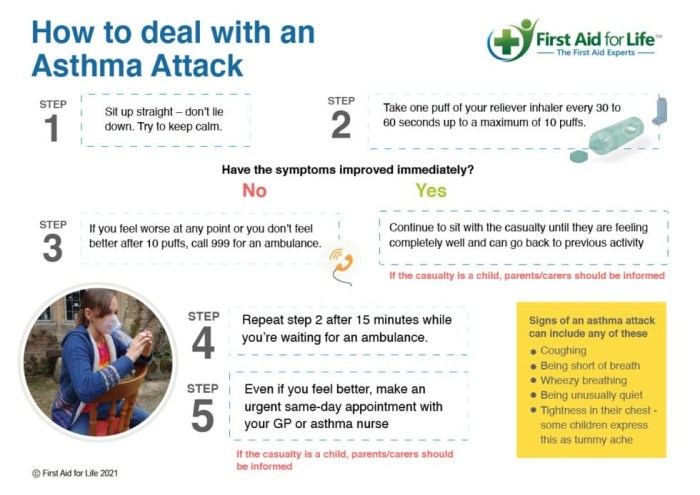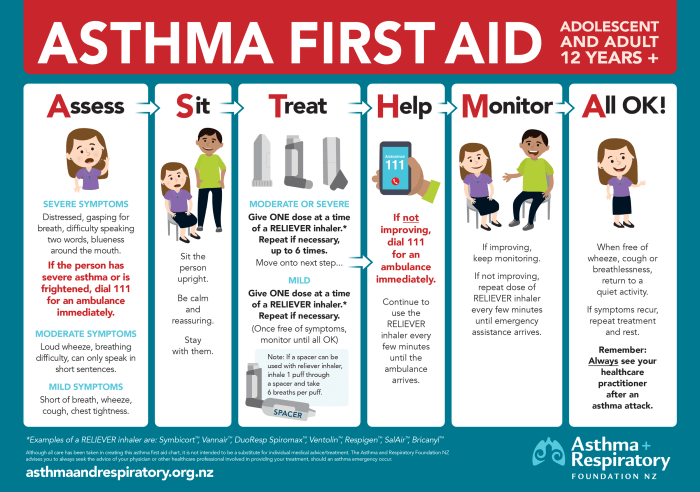
With Emergency Care for Asthma Attacks at the forefront, this paragraph opens a window to an amazing start and intrigue, inviting readers to embark on a storytelling filled with unexpected twists and insights. Asthma attacks can be frightening, but being prepared and knowing how to assist can make all the difference in saving a life. Let’s delve into the crucial steps and strategies for providing emergency care during asthma attacks.
Understanding the symptoms, triggers, and severity levels of asthma attacks is essential. Equally important is recognizing when an attack becomes severe and knowing how to respond with proper emergency care.
Understanding Asthma Attacks

An asthma attack is a sudden worsening of asthma symptoms caused by the tightening of muscles around the airways, inflammation, and excess mucus production. Common symptoms include shortness of breath, chest tightness, wheezing, and coughing.
Triggers of Asthma Attacks
Asthma attacks can be triggered by various factors such as allergens (pollen, dust mites, pet dander), respiratory infections, exercise, smoke, air pollution, strong odors, and changes in weather conditions.
Severity Levels of Asthma Attacks
Mild asthma attacks
Symptoms are mild and can be relieved with the use of a rescue inhaler.
Moderate asthma attacks
Symptoms worsen, making it difficult to speak or perform daily activities. Medical attention may be necessary.
Severe asthma attacks
Symptoms are severe and can be life-threatening, requiring immediate medical intervention and possibly hospitalization.
Emergency Care for Asthma Attacks
Asthma attacks can be frightening, but knowing how to assist someone experiencing one can make a significant difference in their outcome. Here is a step-by-step guide on how to provide emergency care for asthma attacks:
Remaining Calm During an Asthma Emergency
It is crucial to remain calm during an asthma emergency to help the person having an attack feel reassured and supported. Panicking can exacerbate the situation and make it harder for the individual to breathe. Remember that staying calm can help you think clearly and act decisively to assist effectively.
Use of Rescue Inhalers or Nebulizers in Emergency Situations
In emergency situations, rescue inhalers or nebulizers can be lifesaving tools to help open up the airways of someone experiencing an asthma attack. Follow these steps when using rescue inhalers or nebulizers:
- Ensure the person is sitting upright to aid breathing.
- Shake the inhaler or nebulizer as instructed.
- Instruct the individual to take slow, deep breaths to inhale the medication properly.
- Monitor the person’s condition and be prepared to seek medical help if symptoms worsen or do not improve.
Remember, always follow the person’s asthma action plan if they have one, and seek medical assistance if the situation does not improve or if the person’s condition deteriorates. Providing prompt and appropriate care during an asthma emergency can help prevent serious complications and ensure the individual receives the necessary treatment. Stay informed and prepared to assist effectively in case of an asthma attack.
Recognizing Signs of a Severe Asthma Attack
Recognizing the signs of a severe asthma attack is crucial in order to take prompt action and seek medical help when needed. A severe asthma attack can be life-threatening and requires immediate attention to prevent serious complications.
Signs of a Severe Asthma Attack
- Rapid and shallow breathing
- Difficulty speaking due to shortness of breath
- Tightness in the chest that does not improve with medication
- Severe wheezing or coughing
- Retraction of the neck and chest muscles
When to Seek Immediate Medical Help
- If rescue inhaler does not provide relief after several puffs
- If lips or fingernails turn blue
- If breathing becomes extremely difficult and rapid
- If peak flow measurements drop significantly
Difference Between Mild/Moderate and Severe Attacks
In a mild or moderate asthma attack, symptoms can often be relieved with the use of a rescue inhaler and do not typically require immediate medical attention. However, in a severe asthma attack, symptoms worsen rapidly and can be unresponsive to usual treatments, posing a serious risk to the individual’s health.
Medications Used in Emergency Asthma Care

In the event of an asthma attack, it is crucial to have a good understanding of the medications commonly used to alleviate symptoms and manage the situation effectively. Knowing which medications to use and how they work can make a significant difference in providing prompt relief and preventing complications.
Short-Acting Beta Agonists (SABAs)
- Common examples include albuterol (Ventolin, ProAir) and levalbuterol (Xopenex).
- SABAs work by relaxing the muscles around the airways, making it easier to breathe.
- These medications provide quick relief of asthma symptoms, such as wheezing, shortness of breath, and chest tightness.
Systemic Corticosteroids
- Examples include prednisone and methylprednisolone.
- Corticosteroids work by reducing inflammation in the airways, helping to decrease mucus production and swelling.
- These medications are usually prescribed for short-term use during asthma exacerbations to prevent further inflammation.
Anticholinergics
- Commonly used anticholinergic is ipratropium (Atrovent).
- Anticholinergics help to open the airways by blocking the action of acetylcholine, a neurotransmitter that can cause constriction.
- They are often used in combination with SABAs for a more comprehensive treatment approach.
Asthma Action Plan
- Having an asthma action plan is essential for individuals with asthma, outlining steps to take during different scenarios, including asthma attacks.
- It is important to understand which medications to use during an emergency and how to administer them correctly.
- Regularly reviewing and updating the asthma action plan with healthcare providers can help ensure optimal management of asthma symptoms and preparedness for emergencies.
In conclusion, knowing how to assist during an asthma attack can be life-saving. By remaining calm, understanding the signs of severity, and having the right knowledge and tools, you can effectively provide emergency care when it matters most. Stay informed, stay prepared, and stay safe.
Quick FAQs
When should I use a rescue inhaler during an asthma attack?
Use a rescue inhaler when experiencing symptoms such as shortness of breath, wheezing, or tightness in the chest.
What is the difference between a mild and severe asthma attack?
A mild asthma attack may be relieved with a rescue inhaler, while a severe attack requires immediate medical attention as it can be life-threatening.





